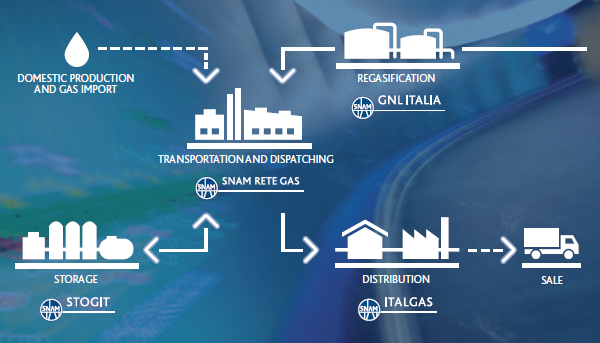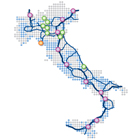CORPORATE MISSION AND VALUES
We are one of Europe’s leading operators in the integrated management and construction of gas infrastructure in terms of regulatory asset base. Our business is the transportation, storage, regasification and distribution of natural gas. We manage a national transportation network that is more than 32,000 km long, including eight storage facilities, one regasification plant and an urban distribution network that covers more than 50,000 km in total.
We provide our customers with a safe and reliable service over time. We do this by using the principles of competition to develop infrastructure and make the gas system more flexible, and by ensuring equal access and treatment for all.
Our aim is to create value so we can fulfil the expectations of all our stakeholders. We pursue this goal with the support of our workforce of more than 6,000 people, who use their unique professional expertise on a daily basis to create growth that is sustainable, environmentally friendly and responsible towards the areas and communities where we work.
Snam’s role in the gas system and its various business segments
Snam conducts activities regulated by the gas segment and is a significant European operator in terms of regulatory asset base (RAB) in its sector.
As an integrated operator providing natural gas transportation, dispatching, storage and distribution services as well as LNG regasification services, Snam plays a leading role in the natural gas infrastructure system.

TRANSPORTATION AND DISPATCHING
Natural gas transportation is an integrated service which involves providing transportation capacity and the actual transportation of the gas delivered to Snam Rete Gas at the entry points of the Italian gas transportation network1 to the redelivery points of the regional network, where the gas is redelivered to users.
The natural gas introduced into the national network originates from imports and, to a lesser extent, national production. The gas from abroad is injected into the national network via seven entry points where the network joins up with the import pipelines (Tarvisio, Gorizia, Gries Pass, Mazara del Vallo and Gela) and with the LNG regasification terminals (Panigaglia and Cavarzere).
Snam Rete Gas is the leading Italian natural gas transportation and dispatching operator, and owns almost all the transportation infrastructures in Italy, with over 32,200 kilometres of high- and medium-pressure gas pipelines (approximately 94% of the entire transportation system).
REGASIFICATION
The process of extracting natural gas from the fields, its liquefaction for shipping and its subsequent regasification for use by the users form the ‘LNG chain’. The process begins in the country of the exporter, where the natural gas is brought to a liquid state by cooling it to -160°C and subsequently loaded onto tankers for shipping to the destination terminal, the ‘LNG regasification terminal’. At the regasification terminal, the LNG is unloaded, then heated and returned to a gaseous state before being injected into the natural gas transportation network.
Natural gas is also injected into the national transportation network by the LNG terminal at Panigaglia (La Spezia), which is owned by the Snam subsidiary GNL Italia and is able to regasify 17,500 cubic metres of LNG per day; when operating at maximum capacity, the terminal can therefore inject over 3.5 billion cubic metres of natural gas a year into the transportation network.
The regasification service includes unloading the LNG from the vessel, operating storage, i.e. the storage time required for vaporising the LNG, regasifying it and injecting it into the national network at the Panigaglia entry point.
STORAGE
The natural gas storage business in Italy is done under a concession regime and it serves to offset the various demands of gas consumption and supply. In fact, procurement has had a basically constant profile throughout the year, while gas demand has been characterised by high seasonal variability with winter demand significantly higher than summer.
Essentially, there are two distinct phases in storage: (i) injection phase, generally concentrated between April and October, consisting of injecting into storage the natural gas deriving from the national transportation network; and (ii) the extraction phase, usually concentrated between November and March of the following year, when the natural gas is extracted from the deposit, treated, and redelivered to users by the transportation network.
The storage business is carried out by making use of an integrated whole of infrastructures comprised of deposits, gas treatment plants, compression plants and the operational dispatching system.
Stogit is the major Italian operator and one of the leading European natural gas storage operators, via eight storage fields in Lombardy (four), Emilia Romagna (three) and Abruzzo (one).
DISTRIBUTION
The natural gas distribution business operates on a concession regime through the conferral of this service by local public entities; it consists of the service of gas distribution through local transportation networks from delivery points at the metering and reduction stations (city gates) to the gas distribution network redelivery points at the end customers (households, businesses, etc.).
Gas distribution service is carried out for sales companies authorised to market to end customers by the transportation of the gas through city networks.
Italgas undertakes natural gas distribution activities by making use of an integrated system of infrastructures comprised of stations for withdrawing gas from the transportation network, pressure reduction plants, local transportation and distribution network, user derivation plants, and redelivery points comprised of technical equipment featuring meters at the end customers.
Italgas is the leading Italian natural gas distributor, with 1,435 municipal concessions and more than 52,500 kilometres of medium- and low-pressure network.
1 The list of pipelines forming part of the national network and the related definition criteria are reported in the Decree of the Ministry of Industry, Commerce and Trade of 22 December 2000 as amended, based on the provisions of Legislative Decree 164 of 23 May 2000 (the ‘Letta Decree’).



